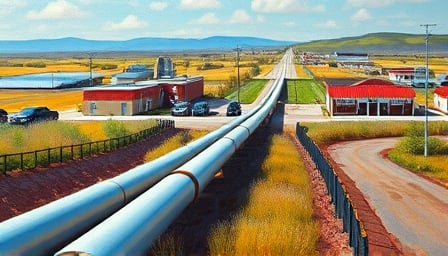Natural Gas Market Dynamics: A Comprehensive Overview
As of August 31, 2025, the natural gas market has been a focal point for investors and industry stakeholders alike. With the close price of natural gas at $3.016 on the New York Mercantile Exchange, the market has seen significant fluctuations over the past year, reaching a 52-week high of $4.901 on March 9, 2025, and a low of $2.075 on September 2, 2024. These movements reflect a complex interplay of global demand, supply chain developments, and strategic investments.
Driving Factors in LNG Market
In a recent episode of Spotlight, John Love from ETFguide.com delved into the driving factors behind natural gas prices. The discussion highlighted the increasing demand for liquefied natural gas (LNG) as a cleaner alternative to coal, particularly in developing countries. This shift is part of a broader trend towards cleaner energy sources, as emphasized by Exxon Mobil’s projection that global natural gas demand will surge by over 20% by 2050. The company’s outlook underscores the role of natural gas in displacing coal and meeting rising electricity needs.
Infrastructure Developments
Infrastructure plays a crucial role in shaping the natural gas market. The Eiger Express pipeline, announced by Austin-based WhiteWater in collaboration with ONEOK, MPLX, and Enbridge, is set to transport up to 2.5 billion cubic feet of natural gas daily from the Permian Basin to Katy, Texas. This project, backed by long-term transportation agreements, is expected to enhance supply reliability and support market stability.
Regional Price Adjustments
On the regional front, Bulgaria has approved a 2.5% reduction in natural gas prices for September, reflecting efforts to manage consumer costs amidst fluctuating global prices. Meanwhile, in India, Oil Marketing Companies (OMCs) have reduced the price of commercial LPG cylinders by ₹51.50, effective September 1, 2025, indicating a strategic response to market conditions.
Corporate and Market Developments
Corporate activities also influence the natural gas landscape. CNOOC’s record-breaking daily production of over 100 million cubic meters in China highlights the country’s commitment to expanding its natural gas output. This achievement is part of a broader strategy to develop a clean energy industry and transition to a new energy system.
In the financial sector, Ellomay Capital reported the publication of Dorad Energy Ltd.’s financial statements, reflecting its increased stake in the company. Such investments signal confidence in the natural gas sector’s growth potential.
Conclusion
The natural gas market in 2025 is characterized by dynamic shifts driven by demand for cleaner energy, strategic infrastructure investments, and regional price adjustments. As the industry continues to evolve, stakeholders must navigate these changes to capitalize on emerging opportunities and address challenges. The ongoing developments underscore the importance of natural gas in the global energy transition, positioning it as a key player in the future energy landscape.
